Jesus was born in Israel, into an observant Jewish family. . . . His father was Joseph, called after a major patriarch who ruled over Egypt under the Pharaoh. Jesus’ mother was Miriam, whom we call Mary, so she was called after Moses’ sister. Jesus’ own name, Iesous in our Greek Gospels, is the Greek equivalent of Yeshua’, which we usually render into English as Joshua. Thus Joseph and Miriam called Jesus after the major figure of Jewish history who succeeded Moses and led Israel across the Jordan into the promised land. At the time his name was understood to mean ‘YHWH saves’ or the like, with the name of God at the beginning, so effectively ‘God saves’. Joseph, Miriam and Jesus must have been aware of this understanding of his name, and it is reflected at Mt. 1.21, where an angel of the Lord tells Joseph that Mary will bear a son ‘and you will call his name Jesus, for he will save his people from their sins’.
Jesus had four brothers. The most famous was Jacob, whom we usually call James, who later led the Jerusalem church and became famous for his piety. He was called after the eponymous patriarch of the whole nation, Jacob who was also known as Israel. The other brothers were Judah, who was probably the author of what we call the epistle Jude, Joseph and Simeon. . . . All known names are patriarchal names. Thus the names of the men in Jesus’ family are straightforward evidence that he was born into a traditional Jewish family, who were expecting the salvation of Israel. (Jesus of Nazareth, p. 143)
There you go. What evidence do we have that Jesus’ parents were an “observant Jewish family”? Why, the father was named Joseph and the mother Mary. That alone tells us — obviously Joseph was named after the patriarch and Mary after Moses’ sister! What other explanation could there possibly be for anyone being given these names? (Anyone curious about the frequency of biblical names in Palestine around this time can thank Richard Bauckham for providing lists for us. These can be accessed via my Bauckham’s Names Tables post.) Continue reading “Biblical Studies: Surely the Softest of Options!”


 Maurice Casey
Maurice Casey The stated purpose of Maurice Casey’s book
The stated purpose of Maurice Casey’s book 

